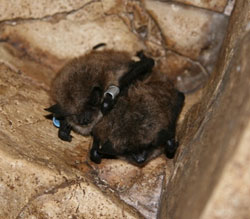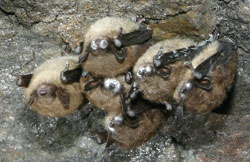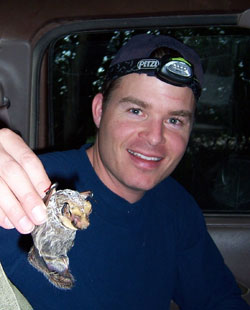WINNIPEG, MB – UWinnipeg assistant professor in biology and resident bat specialist, Dr. Craig Willis and Justin Boyles, a graduate student in biology at Indiana State University have proposed the first possible plan to fight White-nose Syndrome (WNS) deaths in bats. The idea, published this week in Frontiers in Ecology and the Environment e-View could help address this emerging challenge for wildlife conservation.
Baffled Scientists
The syndrome has baffled scientists since its discovery in the winter of 2006 in upstate New York, where hibernating bats were found with a mysterious white fungus growing on their faces and wing membranes. Hundreds of emaciated bats were found dead in and around their caves, suggesting that they had starved to death during hibernation. White Nose Syndrome has now spread to more than seven Northeastern states and killed as many as half a million bats.
Wildlife Issue
“We don’t yet have evidence of this syndrome in Canada but the boundary of the affected area is now right up against the Southern Ontario border,” explained Willis. “The species most affected by WNS is one of our most common and widespread bat species in Canada and we need to start thinking about this as a possible wildlife issue for this country.”
Boyles and co-author Craig are suggesting that providing localized heat sources to the hibernating animals may help save affected bats from dying.
Heat to Beat Starvation
Boyles and Willis tested the idea that the fungus causes bats to spend too much time out of hibernation during the winter. All mammals must rouse from hibernation periodically during winter. However, doing so for too long can deplete their energy reserves prematurely asas it costs energy to stay warm. Bats with WNS may exhaust their fat reserves too quickly and starve to death, say the authors.
Out of Hibernation
Because of the rapid spread of the fungus and the fact that field experiments can take months and even years to complete, Boyles and Willis instead created a mathematical simulation to test the idea that the fungus is causing bats to spend more time out of hibernation. Their model took into account the patterns of arousal, body mass and percentage body fat of a particular species, called little brown bats, which are affected by the fungus.
The simulation showed that the patterns and proportion – about 82 percent – of bat mortality observed in affected populations in the wild are consistent with a large increase in the amount of time spent out of hibernation during the winter months. Their results provide evidence that the fungus is likely affecting bat hibernation patterns.
Mortality Levels Dropped
Boyles and Willis then took the simulation further. Based on the observation that normal bats often fly to the warmest parts of their cave during bouts of arousal, they reasoned that one way to help affected bats fend off starvation would be to provide them with an artificial heat source. That way the bats don’t have to create as much body heat when they rouse. When the authors altered the simulation to include localized heat sources for the bats to gather in after warming up, the model showed that mortality levels dropped to as little as 8 percent.
Critical Stop-Gap
If WNS is transmitted in spring and summer by surviving bats, this plan could potentially cause problems, the authors write, because saving its carriers will also save the disease. However, if the disease is not spread during the summer, as some scientists suspect, then artificial heat sources that improve survival could provide a critical stop-gap to protect bat populations.
“With funding from the U.S. Fish and Wildlife Service, this winter we will be testing whether or not unaffected bats will make use of a prototype artificial thermal refuge to save energy, said Willis. “We’ll be working in a small hibernation site in central Manitoba, an ideal location because it is well outside the affected area so there is no chance that increasing survival could affect the rate that the disease might spread.”







